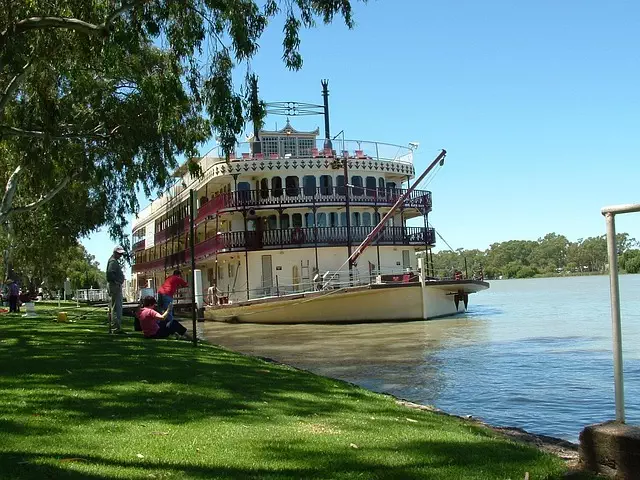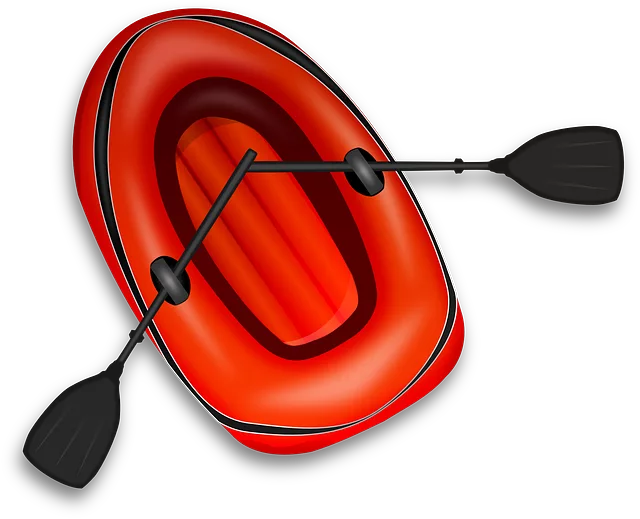Lightweight Inflatable Paddle Boards: Revolutionizing Portability for Water Adventures
Inflatable Paddle Boards (IPBs) have transformed outdoor gear, offering unmatched portability and co…….

Inflatable Paddle Boards (IPBs) have transformed outdoor gear, offering unmatched portability and convenience. These boards can be easily packed into a backpack, making them perfect for travel and exploration. With the help of an electric pump or manual inflation, they transform from compact packages to sturdy watercrafts suitable for calm lakes to choppy seas. Their lightweight design caters to users of all fitness levels, while advanced materials ensure durability. IPBs enable quick access to water, minimizing hassle compared to traditional paddleboards. Modern IPS use materials like PVC and Nylon for enhanced strength, lightness, and longevity, catering to diverse user needs. When choosing an IPB, consider board dimensions, weight capacity, and air pressure for optimal transportability and performance. Regular care is crucial to prolong their lifespan. IPBs offer a compact solution for outdoor enthusiasts seeking water activities without heavy equipment, revolutionizing recreational sports and making them more accessible.
“Unleash your adventurous spirit with the lightweight and portable inflatable paddle board revolution. This modern gear is transforming water sports, offering a convenient and accessible way to explore lakes, rivers, and coastal waters. In this comprehensive guide, we’ll navigate the world of inflatable paddle boards (IPBs), exploring their design, benefits, and real-life applications. From understanding key features to choosing the perfect board and ensuring proper care, get ready to dive into the future of water adventures.”
Understanding Inflatable Paddle Boards: A Modern Adventure Gear

Inflatable paddle boards (IPBs) have emerged as a game-changer in modern adventure gear, offering unparalleled portability and convenience for outdoor enthusiasts. These innovative products can be easily packed into a backpack, making them ideal for travel and exploration. An IPB is essentially a rigid board designed to be inflated with an electric pump or manual effort, transforming it from a compact package into a sturdy watercraft capable of supporting users in various water bodies—from calm lakes to choppy seas.
The lightweight nature of inflatable paddle boards makes them accessible to a wide range of users, including those who may not have the strength or capacity to handle traditional, solid paddleboards. Their durability, coupled with advanced materials and construction techniques, ensures they withstand the rigors of outdoor use. With just a few simple steps, an IPB can be inflated, allowing users to hit the water quickly and get back to their adventures without the hassle associated with conventional boards.
The Concept of Lightweight Design for Portability

Lightweight design is a key concept in enhancing portability, particularly evident in popular outdoor gear like inflatable paddle boards (IPS). By prioritizing minimalism and reduced weight, IPS manufacturers enable users to easily transport and store these versatile watercraft. This approach not only makes them ideal for travel but also ensures that anyone, regardless of physical strength or fitness level, can enjoy a day on the water.
The focus on lightness is achieved through innovative materials science and smart design. Inflatable materials, such as durable yet thin PVC, allow for quick inflation and deflation, while sophisticated valve systems ensure efficient air retention. These features contribute not only to the overall lightweight profile but also make IPS setup and takedown a breeze.
Benefits of Portable Paddle Boarding

Portable paddle boarding offers a host of benefits, especially thanks to its lightweight and inflatable design. One of the most appealing advantages is the ease of transport it provides. An inflatable paddle board (IPB) can be packed down into a compact size, making it convenient for travelers or those with limited storage space. Whether you’re heading on a camping trip, exploring a new lake, or simply enjoying a day at the beach, an IPB allows you to bring your favorite water sport wherever you go.
Furthermore, these boards offer versatility and accessibility. They are suitable for people of various skill levels, from beginners to experienced paddlers, as their design makes them stable and easy to maneuver. The portability also opens up opportunities for spontaneous water adventures, encouraging a more active and adventurous lifestyle.
Key Features to Look For in a Lightweight Inflatable Board

When choosing a lightweight inflatable paddle board (IPB), several key features should be at the forefront of your consideration. Firstly, look for boards made with high-quality, durable materials that are designed to withstand regular use and exposure to water. These materials often include robust PVC or drop-stitch construction, ensuring both strength and lightness without compromising safety.
Additionally, consider the board’s dimensions and weight capacity. A lighter IPB will be easier to carry and transport, so opt for models that offer a balance between compactness and stability. Air pressure is another critical factor; higher pressure can make inflating faster and provide better performance on the water, while lower pressure may add some extra comfort but could slightly increase the overall weight.
Top Materials Used in Modern Inflatable Paddle Boards

In modern inflatable paddle boards, several top materials are revolutionizing the portability and performance of these versatile watercraft. One of the most widely used is PVC (Polyvinyl Chloride). Known for its durability and resistance to punctures, PVC ensures that inflatable paddle boards can withstand rough waters and frequent use. This material also provides excellent buoyancy, making it ideal for various water activities.
Another notable material is Nylon. Lighter than PVC yet equally robust, nylon inflatable paddle boards offer superior flexibility and a smoother ride on the water. They are often coated with UV-resistant layers to protect against sun damage, extending the lifespan of the board. Nylon’s breathability also helps in quick drying, making it a popular choice for those seeking a more lightweight and portable option without compromising durability.
How to Choose the Right Lightweight Board for Your Needs

When choosing a lightweight inflatable paddle board (IPB), consider your primary use. If it’s for leisure paddling on calm waters, opt for a smaller, thinner board that’s easier to handle and store. Look for boards with lower air pressure recommendations, as these are generally lighter and more portable.
For fitness enthusiasts or those who plan to navigate choppy waters, sturdier models with additional features like reinforced decks and higher pressure ratings might be the way to go. Ensure you choose a board with adequate buoyancy to support your weight, especially if you’re larger or planning to carry gear.
Care and Maintenance Tips for Longevity

To ensure your inflatable paddle board (IPB) lasts for years, proper care and maintenance are paramount. Begin by regularly cleaning your IPB after each use with fresh water and a mild detergent. Avoid using abrasive materials or harsh chemicals, as these can damage the material. After cleaning, thoroughly dry your board to prevent mold and mildew from forming, especially in humid environments.
Store your IPB in a cool, dry place when not in use. Never leave it exposed to direct sunlight or extreme temperatures for extended periods. Periodically check for any signs of wear and tear, such as punctures or tears, and repair them promptly using recommended repair kits. Inflation pressure should also be checked regularly, ensuring it’s within the manufacturer’s specified range to maintain optimal performance and longevity.
Real-Life Applications: Where Lightweight Paddle Boards Shine

Inflatable paddle boards (IPBs) excel in various real-life scenarios due to their lightweight design. Their portability makes them an ideal choice for outdoor enthusiasts who enjoy water activities but have limited access to heavy equipment. For instance, campers and backpackers can easily pack a lightweight paddle board into their backpacks, transforming still bodies of water into opportunities for exercise and exploration.
IPBs are also popular among urban dwellers who seek recreational activities without the hassle of bulky gear. They fit seamlessly in the trunk of a car or even smaller storage spaces, allowing users to quickly set up for a day on the lake or river. This versatility makes inflatable paddle boards an attractive option for anyone looking to enjoy water sports without the usual investment and storage challenges associated with traditional, rigid boards.
The Future of Portable Water Sports Equipment

The future of portable water sports equipment looks bright, with innovations centered around lightweight and compact designs. Inflatable paddle boards (IPBs) are leading this trend, offering a versatile and accessible way to enjoy water activities without the bulk and hassle of traditional gear. IPBs can easily fit into small bags or even carry-on luggage, making them ideal for travelers who want to explore rivers, lakes, or seas during their vacations.
As technology advances, we can expect IPBs to become even lighter, sturdier, and more durable. Integrating innovative materials and smart design elements will enhance their performance while reducing weight. This evolution will make water sports more inclusive, encouraging people from all walks of life to try their hand at activities like stand-up paddleboarding (SUP) without the usual barriers of entry.







